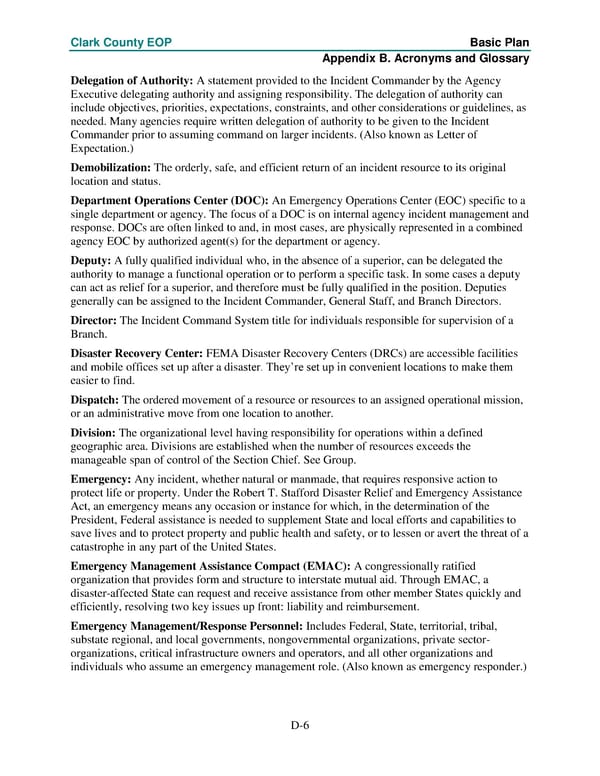Clark County EOP Basic Plan Appendix B. Acronyms and Glossary Delegation of Authority: A statement provided to the Incident Commander by the Agency Executive delegating authority and assigning responsibility. The delegation of authority can include objectives, priorities, expectations, constraints, and other considerations or guidelines, as needed. Many agencies require written delegation of authority to be given to the Incident Commander prior to assuming command on larger incidents. (Also known as Letter of Expectation.) Demobilization: The orderly, safe, and efficient return of an incident resource to its original location and status. Department Operations Center (DOC): An Emergency Operations Center (EOC) specific to a single department or agency. The focus of a DOC is on internal agency incident management and response. DOCs are often linked to and, in most cases, are physically represented in a combined agency EOC by authorized agent(s) for the department or agency. Deputy: A fully qualified individual who, in the absence of a superior, can be delegated the authority to manage a functional operation or to perform a specific task. In some cases a deputy can act as relief for a superior, and therefore must be fully qualified in the position. Deputies generally can be assigned to the Incident Commander, General Staff, and Branch Directors. Director: The Incident Command System title for individuals responsible for supervision of a Branch. Disaster Recovery Center: FEMA Disaster Recovery Centers (DRCs) are accessible facilities and mobile offices set up after a disaster. They’re set up in convenient locations to make them easier to find. Dispatch: The ordered movement of a resource or resources to an assigned operational mission, or an administrative move from one location to another. Division: The organizational level having responsibility for operations within a defined geographic area. Divisions are established when the number of resources exceeds the manageable span of control of the Section Chief. See Group. Emergency: Any incident, whether natural or manmade, that requires responsive action to protect life or property. Under the Robert T. Stafford Disaster Relief and Emergency Assistance Act, an emergency means any occasion or instance for which, in the determination of the President, Federal assistance is needed to supplement State and local efforts and capabilities to save lives and to protect property and public health and safety, or to lessen or avert the threat of a catastrophe in any part of the United States. Emergency Management Assistance Compact (EMAC): A congressionally ratified organization that provides form and structure to interstate mutual aid. Through EMAC, a disaster-affected State can request and receive assistance from other member States quickly and efficiently, resolving two key issues up front: liability and reimbursement. Emergency Management/Response Personnel: Includes Federal, State, territorial, tribal, substate regional, and local governments, nongovernmental organizations, private sector- organizations, critical infrastructure owners and operators, and all other organizations and individuals who assume an emergency management role. (Also known as emergency responder.) D-6
 Emergency Operations Plan Page 109 Page 111
Emergency Operations Plan Page 109 Page 111